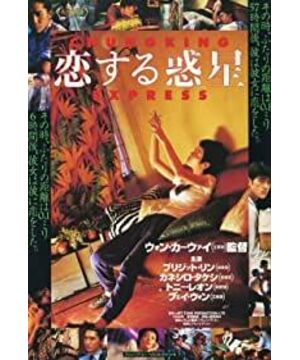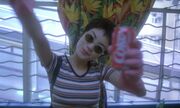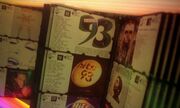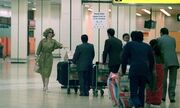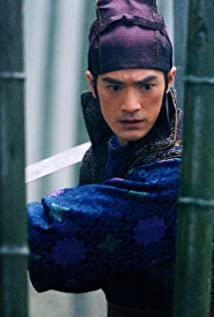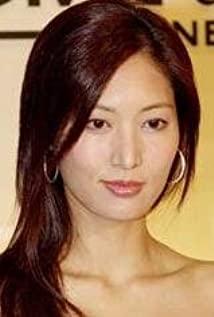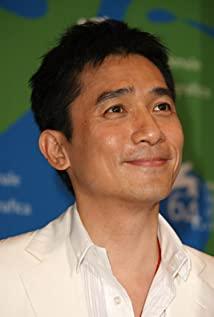After the reform and opening up, cultures from various countries flowed into the mainland like a wave. Traditional culture is intertwined with various foreign cultures. And we are lost in the waves of the offensive, in the intertwined cultures. Everyone presents a morbid impetuousness and unease, and Wong Kar-wai's "Chongqing Forest" also shows us the dazed interweaving of cultures through a reasonable background, exquisite and textured shots, and ingenious movements of sound and painting. of men and women.
The use of a reasonable background in the corresponding era is one of the factors of the film's success. The shooting location of Chongqing Forest was not in Chongqing. Director Wang aimed the camera at a building in Hong Kong under British colonialism. There, you can see people from all over the world with different accents. Such as a foreigner from the Philippines and a yellow man can communicate in English proficiently. Someone said: There you can find all kinds of different types of items, a bible, a pistol, even a pack of drugs. It is under such a background that the collision and conflict of cultures become more obvious and intense, and the confusion of human nature becomes more direct and reasonable.
The use of delicate and textured lenses powerfully shows the struggle of human nature in the daze. In the opening, a series of elevated long shots are presented through a handheld pan, with half warm and half cool tones interweaving with nostalgic undertones. Takeshi Kaneshiro's running in the picture becomes uncertain because of the panning. This set of rich lens language directly shows the confusion of the policeman played by Takeshi Kaneshiro under the cultural conflict. And the scene of running in the rain that followed. Takeshi Kaneshiro chose to run in order to escape this dazed and unreal feeling, and Director Wang chose to follow the camera. In the picture, the line of sight is directly on the back of Takeshi Kaneshiro, unable to see the road ahead. Then, using an overhead shot, it was seen that it was a circular runway, in which people circled in circles, never ending. In the second story, after the policeman played by Tony Leung learned about the breakup, the director chose a fixed shot, and the characters' positions at this time were also quite interesting. Tony Leung is on the left and Faye Wong is on the right. There is a long counter between them. The working girl played by Faye Wong has silently developed a love for Tony Leung, while Tony Leung stood on the left with dull eyes, obviously thinking about his ex-girlfriend. At this point, the background begins to blur, and a large number of blurred and flowing silhouettes fill the screen. The inner restlessness and the blurry confusion in front of me are shown through the camera, without a word, and it is all romantic. Director Wang is often able to sharply and accurately depict plump characters and inner monologues through the lens.
In "Chongqing Forest", the ingenious movement of sound and picture is the highlight of the film. In Wang-style films, nostalgic images are often organically integrated with the characters' inner monologues. The perfect unity of its aesthetics and melancholy literary atmosphere constitutes a scene of classic images. For example, Zhou Xingchi's "Journey to the West" paid tribute to Wang style literature and art. And its source is in the forest of Chongqing. Jin Chengwu was eating an expired canned pear and said in a monologue: If there is a deadline, I hope it will be 10,000 years. The piles of canned pears and the monologues of the characters in the picture are easy to bring the audience into it and indulge in it. Another example is that after Jin Chengwu was drunk, he used Japanese, English, and Cantonese about three ladies with different languages and cultures. From here, we can see the fierce collision of cultures. For another example, Liang Langwei's monologue in the room: "The towel with emotion and the thin soap", this time with cool tones, the sense of immersion is stronger, and the audience sheds tears. The length of the towel, the fat and thinness of the soap, the American Garfield or the domestic bear, he can't tell the difference, because he has been lost and can only take a flight to fill the confusion of human nature in love. The background music "California Dream" and "Dream Man" are also the collision of Chinese culture and foreign culture, the interweaving of enthusiasm and continuity, and lost in the dream in the collision.
Perhaps in today's fierce cultural conflict, each of us is lost. We are often unable to fill the daze in our hearts, so as to draw warmth in love. This flight has gone, the cans have expired, and there will be another flight, the next box of cans. Can this freshness really fill the daze inside?
View more about Chungking Express reviews


